Facts
The evidence in the records discloses a conspiracy of amazing magnitude to import, possess, and sell liquor unlawfully. Involved were not less than fifty employees, two sea-going vessels for transportation of the goods to British Columbia, a ranch beyond the city limits of Seattle with a large underground cache to store the liquor, and many other caches around the area of Seattle, a maintained city office with executives, secretaries, salesmen, deliverymen, dispatchers, bookkeepers, collectors, scouts, and an attorney. Olmstead was the leading conspirator and manager of the business. His invested capital brought him 50 percent of the total income of the company (said to be over 2 million/year), and the other 50 percent went to 11 other investors.
In the main office building there were three different telephones with separate lines for each. Telephone communication was made throughout the city, the homes of the investors, customers, Vancouver, to and from the office building and ranch. Times were fixed for the delivery of the “stuff” to places along the Puget Sound and from there was transported to the various caches.
The information leading to the arrests was made primarily by four Federal prohibition officers. The officers placed small wires along the main lines outside the homes of the four main conspirators and that of the office. No intrusion was made into private property. Olmstead was found to have made dealings with members of the Seattle police to secure the release of any of the conspiring parties that might get arrested.
Procedural History
Petitioners were convicted in the District Court of the Western District of Washington for conspiracy to violate the National Prohibition Act. The conviction was upheld upon appeal to the Ninth Circuit Court of Appeals. The case was granted writ of certiorari to the US Supreme Court.
Legal Issue
Whether the use as evidence of private telephone conversations between the defendants and others, intercepted by means of wiretapping,  amounted to a violation of the fourth and fifth amendments.
amounted to a violation of the fourth and fifth amendments.
Holding
The Court held that the use of wiretaps to obtain evidence is not a violation of the Fourth Amendment protecting against unreasonable searches and seizures, since the information obtained was neither material, nor was it a thing to be seized.
Judgement
The decision of the lower courts were upheld.
Legal Reasoning
1. “There is no room in the present case for applying the 5th amendment unless the fourth was first violated. . .[petitioners] were continually and voluntarily transacting business without knowledge of the interception.”
2. The well-known purpose of the 4th was to protect against general warrants and writs of assistance to prevent the use of governmental force to search a citizen’s house, his person, papers, and effects and their seizure against his will. The amendment protects material things. The description on the warrant necessary to make the proceeding lawful must specify the persons or things to be seized.
3. There was no searching. There was no seizure.
4. No entry in the defendants’ houses.
5. The wording of the 4th cannot be extended to included telegraphs and telephones that reach to the whole world from the defendant’s house (or office.) “The intervening wires are not part of his house or office, any more than are the highways along which they are stretched.”
Dissenting opinion
Written by Justice Brandeis. He quotes Chief Justice Marshall in M’Culloch v. Maryland when he says, “We must never forget that it is a Constitution we are expounding.” Since then, Brandeis says, the Supreme Court has continuously sustained the exercise of power by Congress over objects which the founding fathers could have never dreamed. As time goes on, there become more and more ways for the government to intrude upon the privacy of the citizen (through technology.)
“Advances in the psychic and related sciences may bring means of exploring unexpressed beliefs, thoughts and emotions.”
The founding fathers, in writing the Constitution, knew that only part of the pain, pleasure, and satisfaction of life could be found in the material things. They wished to protect the beliefs, thoughts, and emotions of the individual, to ultimately protect his privacy, his right to be alone, the value most highly kept by civilized men.
Hence any intrusion upon that privacy is subject to the 4th amendment protections.
[Government cannot be allowed to commit crimes in order to apprehend the private criminal. Crime is contagious. If the government breaks the law, it breeds a general contempt for the law.]
